Cameron In York: ‘No north/south divide in flood defences’
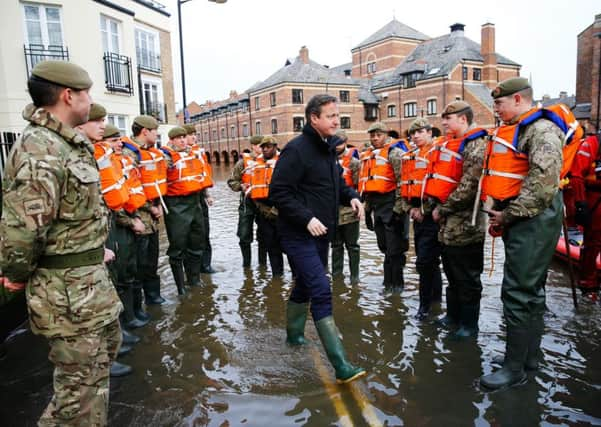

Mr Cameron was heckled as he arrived in the city, where large swathes remain submerged today and hundreds of homes have been evacuated.
One woman shouted: “No more cuts to public services” as he spoke to a team from the Scarborough mountain rescue, who had deployed with a dinghy on a submerged street in the city centre.
Advertisement
Hide AdAdvertisement
Hide AdThe Prime Minister met some of the 500 military troops who had been mobilised to aid emergency services, with another 1,000 on standby should the situation worsen.
As he visited a sand bag filling station on the outskirts of the city after meeting with officials coordinating the response, Mr Cameron hailed the “amazing” response of the emergency services and volunteers.
He said it was untrue that funding for flood defences had seen a 20 per cent cut but insisted a major review of policy would look at whether more needed to be done and whether the strategy should be changed.
“We spent more in the last parliament than the previous parliament and we are going to spend even more in this parliament. So it is a rising budget - £2.3 billion on capital schemes that will make a real difference up and down the country,” he told Sky News.
Advertisement
Hide AdAdvertisement
Hide Ad“As I say, though - let’s have a look and see if more needs to be done and whether the flood defences need to be made higher than they have already, and that’s exactly what we’ll look at.
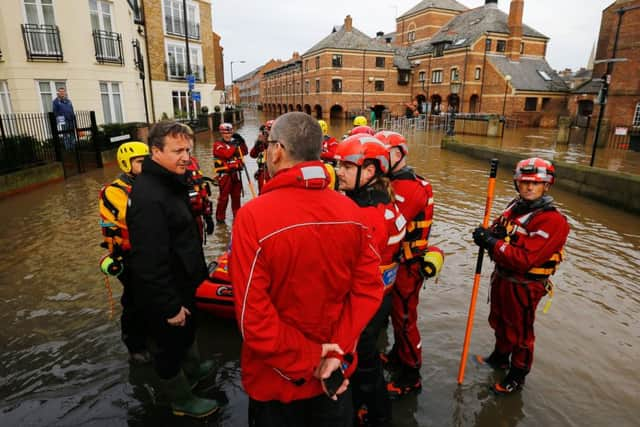

He hit back at a claim by the leader of the council in flood-hit Leeds, Judith Blake, that northern cities were the victim of “preventable” disasters and said people felt “very strongly” that more help was given to the south.
“We spend more per head of the population on flood defences in the north than we do in the south,” Mr Cameron said.
“But the key thing is to spend the money where it’s needed.
“Here in Yorkshire, for instance, we’ve spent £100 million on flood defences since I became Prime Minister. We plan to spend, in this parliament, an extra £280 million, so almost three times as much again.”
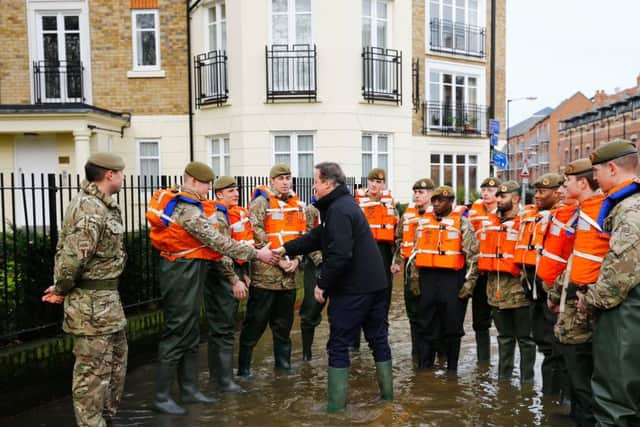

Advertisement
Hide AdAdvertisement
Hide AdBut with more rain forecast for the middle of the week there may be worse to come, and the Environment Agency (EA) still has nine severe flood warnings in place - meaning there remains a danger to life.
Rain will batter the north of England on Wednesday with up to 3in (80mm) falling on high ground and potentially in excess of 4.7in (120mm) in exposed locations - with most places seeing up to 1.5in (40mm).
The Met Office has issued yellow warnings for rain on Wednesday in North West England, North East England, Yorkshire and Humber, Wales and Northern Ireland.
Amber warnings for rain are in place for parts of Scotland on Wednesday too.
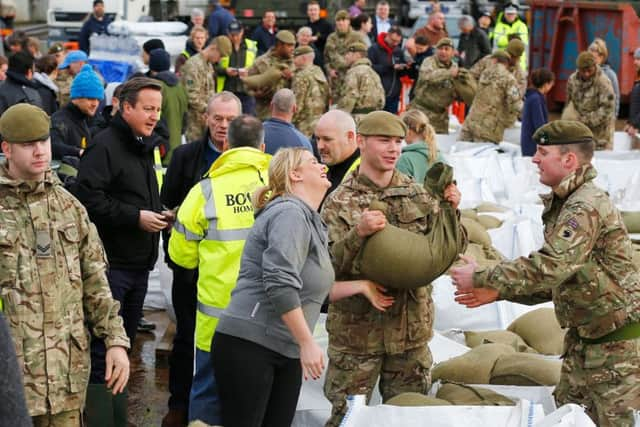

Advertisement
Hide AdAdvertisement
Hide AdArriving in York by helicopter, Mr Cameron saw the scene of devastation wreaked by the raging Ouse.
He landed shortly before 10.15am at North Yorkshire police’s headquarters, around a mile from the city’s medieval centre.
Meanwhile the thump of Chinook helicopters could be heard overhead as they dropped supplies nearby.
Officials from the Environment Agency, Army, emergency services and local council are using the base as the headquarters for coordinating flood relief effort across York.
Advertisement
Hide AdAdvertisement
Hide AdMr Cameron was briefed by the silver command task force overseeing the response that began when floods hit on Boxing Day.
He was shown images of a caravan park by the river Nidd, a tributary of the Ouse in Knaresborough, where residents were evacuated before the site was inundated.
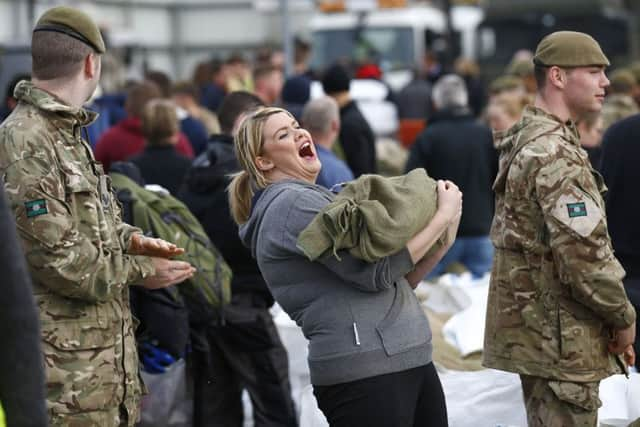

Officials explained how a flood barrier on the river Foss had to be opened after water entered a pump room, putting the electrical machinery in danger.
If the barrier was disabled in the down position it would have left a wider area at risk of serious flooding, they explained.
Advertisement
Hide AdAdvertisement
Hide AdA 999 call handler told Mr Cameron how residents left without landline phone services had been further cut off by intermittent issues with mobile phone signal.
After spending around an hour at the nerve centre Mr Cameron was taken by car to see the devastated city centre.
Stopping at Skeldergate in the town centre he met with members of the military and Scarborough and Woodhead mountain rescue service, who described the challenges of navigating streets littered with hidden obstacles.
He thanked the team, telling them “keep it up, thanks very much”.
Advertisement
Hide AdAdvertisement
Hide AdTwo residents told him how water had inundated their homes but they had decided to stay put.
Mr Cameron then moved on to a depot where the army and scores of volunteers were helping to fill sandbags.
Speaking to volunteer Peter Gribbon, 28, he said: “This is really vital, the water level is going down but if more rain comes this is what we will need.”
The Met Office has issued yellow warnings for rain on Wednesday in North West England, North East England, Yorkshire and Humber, Wales and Northern Ireland.
Advertisement
Hide AdAdvertisement
Hide AdAmber warnings for rain are also in place for parts of Scotland on Wednesday.
The Government has vowed to look again at the quality of the UK’s flood defences as homes and business owners face up to a miserable start to the new year.
Emergency financial assistance will also be put in place for affected areas, and homes and businesses damaged by flooding will have access to the same package of support announced for those affected by Storm Desmond.
Speaking at the sandbag depot, Mr Cameron said: “We are spending more in this parliament than the last one and in the last parliament we spent more than the one before that.
Advertisement
Hide AdAdvertisement
Hide Ad“I think with any of these events we have to look at what we are planning to spend and think: Do we need to do more?
“We are going to spend £2.3 billion on flood defences in this parliament but we will look at what’s happened here and see what needs to be done.
“We have to look at what’s happened in terms of the flooding, what flood defences have worked and the places where they haven’t worked well enough, and see if there’s more that we can do.”
Mr Cameron said £100 million had been spent in Yorkshire on flood defences since 2010 and there are plans to invest a further £280 million.
Advertisement
Hide AdAdvertisement
Hide AdHe added: “But that’s of no comfort, obviously, to the people who have been flooded here in York, all our hearts go out to them.
“To be flooded is a terrible experience anyway and it’s even more terrible at Christmas and New Year, a time when people are meant to be at home with their families and celebrating.”
Mr Cameron thanked the emergency services and said those who had been flooded deserve “huge amounts of sympathy and understanding”.
The Prime Minister rejected allegations of a North/South divide in funding for flood defence projects, with some claiming there would be more investment had flood-hit areas been in the south of the country.
Advertisement
Hide AdAdvertisement
Hide AdHe said: “That’s not the case. We spend more per head on flood defences in the North of England than we do in the South of England, and here in Yorkshire we are almost trebling the amount we will be spending in the current parliament.
“What matters is that we spend the right amount in the right places, and that’s what our review will make sure is happening.”
Mr Cameron said the Government would be implementing a “bell wind” scheme.
He explained: “That means everything that local authorities have to spend over the initial threshold, all of that gets reimbursed by the Government, so that’s important to know.
Advertisement
Hide AdAdvertisement
Hide Ad“Also, the schemes we put in place to help households, to help businesses in Cumbria, those will be available in Lancashire and they will also be available here in Yorkshire too.”
Military personnel were mobilised on Sunday to help people in Yorkshire and Lancashire as they battled to keep rising flood waters from the doors of their homes and businesses.
But sandbags were not enough to save some, and hundreds of people had to be evacuated from their homes after rivers in York, Leeds and Manchester burst their banks after “unprecedented” rain in recent days.
The EA has 24 severe flood warnings in place for the North East and three severe flood warnings in place for the North West.
Advertisement
Hide AdAdvertisement
Hide AdThere are almost 200 other flood warnings and alerts in place across the area and other parts including Wales and the Midlands.
The Government has vowed to look again at the quality of the UK’s flood defences as home and business owners face up to a miserable start to the new year.
Emergency financial assistance will also be put in place for affected areas, and homes and businesses damaged by flooding will have access to the same package of support announced for those affected by Storm Desmond.
Mr Cameron praised the efforts of the emergency services and said that with the prevalence of such extreme weather events on the rise, investment in flood defences would continue.
Advertisement
Hide AdAdvertisement
Hide AdShadow environment secretary Kerry McCarthy said the Government must “drop its complacency” over the need for climate change adaptation.
One of the worst-hit areas was York, where large swathes of the city are under water after the Foss and Ouse rivers topped their banks.
The Ouse stabilised this morning at 5.7 yards above its normal level, a spokeswoman for the Environment Agency said.
The barrier gate on the Foss was raised after water entered the Foss barrier building, and engineers are examining how to restore power to the site.
Advertisement
Hide AdAdvertisement
Hide AdAround 500 properties were flooded in the city on Sunday. Troops spent the day stacking sandbags but the flooding was so bad the council ran out and begged nearby councils for help.
Hundreds were forced to leave their homes as residential streets were turned into muddy rivers, taking shelter in emergency rest centres as waters reached record levels.
Thousands of homes in northern England were left without power, with almost 6,000 hoping to be reconnected today.
One of the flooded substations was in Rochdale, which five years ago had its flood defences given a £470,000 upgrade to protect power supplies against a “1-in-200-year” flood.
Advertisement
Hide AdAdvertisement
Hide AdThe floods also affected transport links in the North. Some 16 road closures were in effect in Cumbria, while Northern Rail urged passengers not to travel in Cumbria, East Lancashire and West Yorkshire unless their journey is “absolutely necessary”.
Many places have seen record river levels over the past 24 hours, including the River Aire in Leeds, and the rivers Calder and Ribble, affecting places such as Whalley, Hebden Bridge and Ribchester.
West Yorkshire Police declared a major incident after responding to what it said was the “worst flooding in 70 years” in the area.
Some 100 soldiers were deployed to the county to help emergency services in the hardest hit areas of Calderdale and Leeds.
Advertisement
Hide AdAdvertisement
Hide AdDozens of rescues have been carried out across northern England, including one in the town of Mytholmroyd, where an elderly man was hauled through the sunroof of his 4x4 by rescuers just as flood waters reached the roof of his vehicle.
Judith Blake, the leader of Leeds City Council, said the authority had warned the Government that flooding in Leeds was a “catastrophe waiting to happen”.
She called for “significant investment” in additional flood defences for the city to prevent future flooding.
News of the flooding has even reached space, where Major Tim Peake passed over the UK on Sunday in the International Space Station.
Advertisement
Hide AdAdvertisement
Hide AdHe tweeted: “Passed over UK today - thoughts are with all those affected by flooding in northern England.”
Charlie Croft, from York City Council, confirmed that river waters in the city had peaked, telling the BBC: “We have to say that we are still in the middle of a major incident, though tentative positive news is that the river may now have stopped rising at this point.”
Lord Deben, chairman of the Government’s Advisory Committee on Climate Change, accused ministers of failing to match the UK’s words at the recent United Nations climate conference with action at home.
The committee’s recommendations for “measures which would stop some of the real damage” had not been taken up, he complained.
Advertisement
Hide AdAdvertisement
Hide AdThat included using the Housing Act to prevent further developments in at-risk areas and giving water companies a statutory role in the planning process.
“All those things would help us make things better in the future but I am afraid so far no government - Labour, Conservative or coalition - has been prepared to take those steps,” the Tory former environment secretary told the BBC Radio 4 Today programme.
“If you go to Paris and you say climate change is as serious as it is; if you take a leading part in changing the world’s attitude, which is what this Government did; if you contribute large sums, very generously, to helping poorer countries do something about their adaptation, you really do have to look at what is happening in Britain and take the sort of steps that are necessary to protect the people of Britain in the future,” the Tory peer said.
He dismissed calls however for measures to be funded by reducing foreign aid.
Advertisement
Hide AdAdvertisement
Hide Ad“We should certainly be helping the overseas aid because they are going to affect our climate just as much as we affect our own.
“But we should also be doing something about our own adaptation, just as we should stop building houses that we are going to have to retrofit within 20 years because we haven’t done what we should have done about insulation and protection for them.
“We really do have to look forward and put into practice what we have said so clearly at the Paris discussions, where we took a leading part.
“We should do at home what we insist happens right around the world.”
Advertisement
Hide AdAdvertisement
Hide AdEnvironment Agency deputy chief executive David Rooke said a “complete rethink” of the UK’s flood preparations had to include making homes more resilient as well as seeking to hold back waters.
“We are in a period of known extremes and we are moving into a period of unknown extremes,” he told Today - saying a Government-ordered review would decide by the summer whether existing assumptions remained valid.
He said: “We will need to have that complete rethink and I think we will need to move from not just providing better defences - and we have a £2.3 billion programme to do that over the next six years - but looking at increasing resilience so that, when properties do flood, they’ve got solid floors, we have waterproof plaster, we’ve moved the electrics up the wall, people can get back into their homes, their businesses, very quickly and that we continue to improve our flood warning systems so that, in the event of defences overtopping, people have time to take action and we can save lives.”